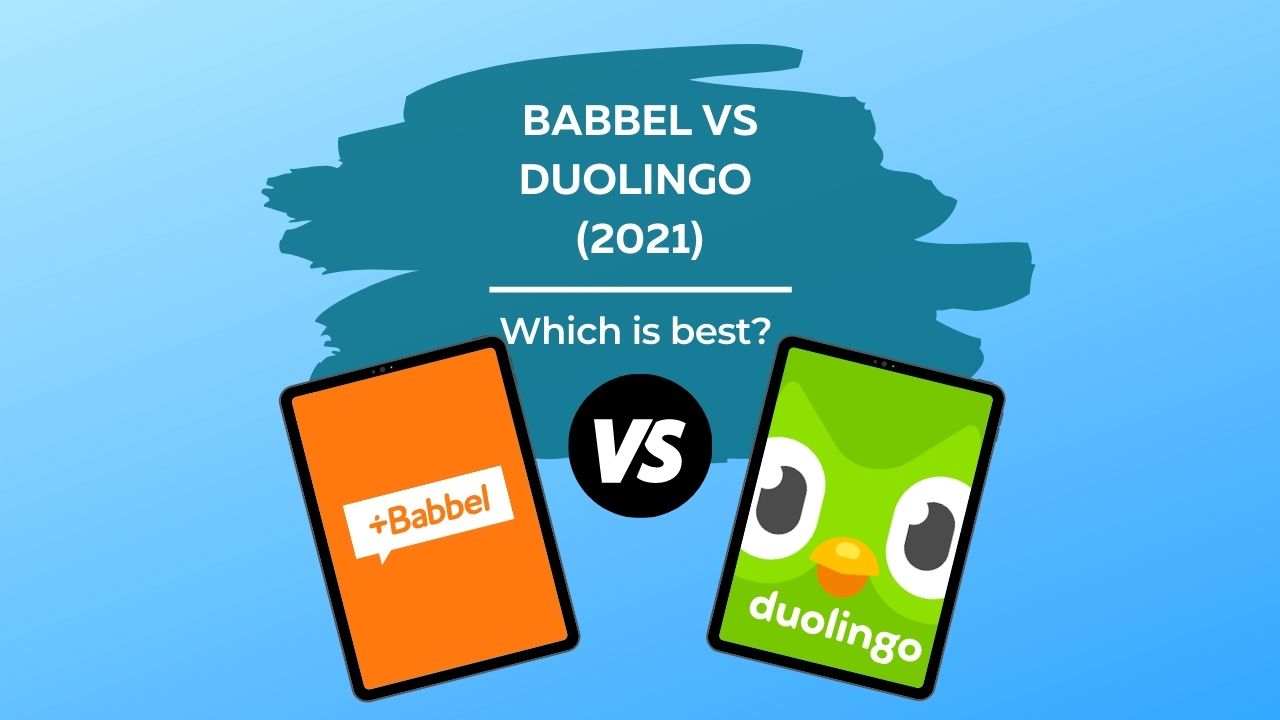
Overview Of Babbel vs Duolingo
This article is a comparison between two hugely popular language-learning apps: Babbel vs Duolingo. Both are online resources for learning languages through quiz- or game-style lessons. Both are easily accessible on desktop as well as iPhone and Android devices.
In this review, I’ll take you into the members areas of both apps and show you their main features, then share my honest conclusion on which is better.
Main Differences
Duolingo:
- Free to learn as many languages as you want, for as long as you want (with a paid option that removes ads and lets you download lessons)
- Motivating, addictive gameplay
- 37 languages
Babbel:
- Paid subscription (you pay per language)
- More structured & comprehensive learning, but less fun
- 13 languages
The Cost
Duolingo: Free. There is a premium subscription option called Duolingo Plus that costs $83.88 for one year.
Babbel: A 12-month course costs US $83.40 for one language.
Babbel vs Duolingo: The Verdict
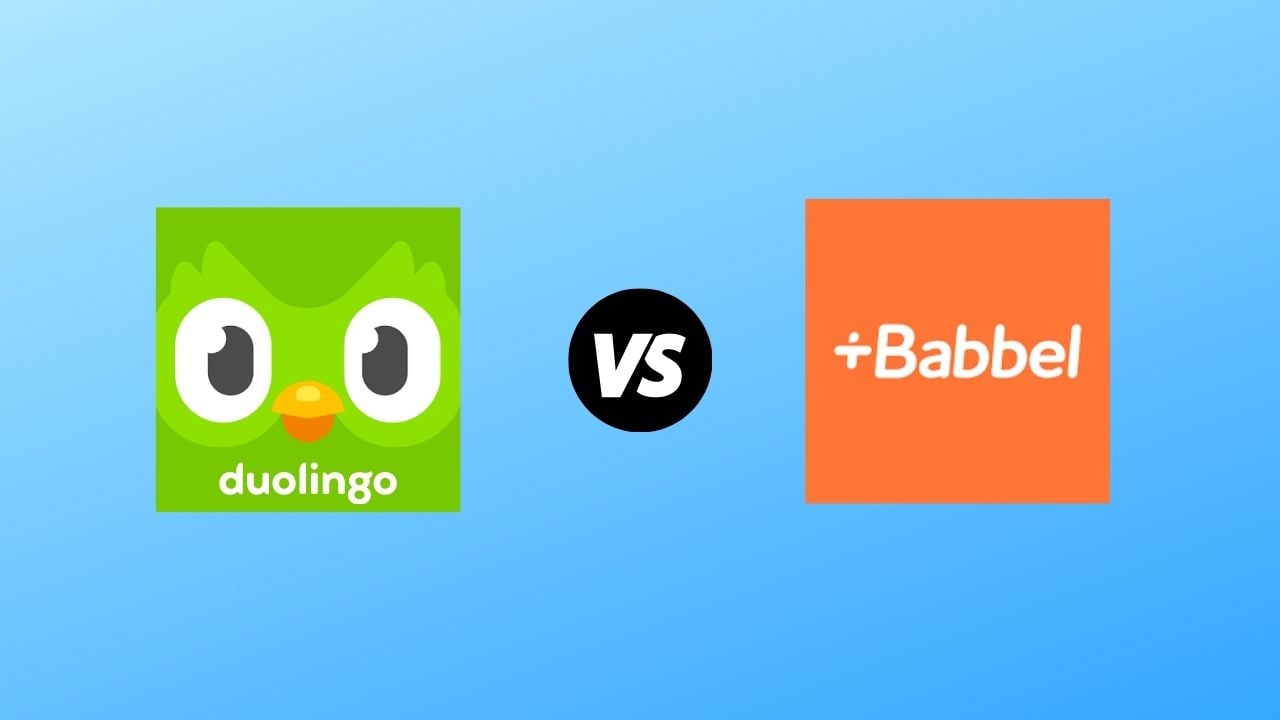
Duolingo and Babbel are two similar apps, so your choice really comes down to what you want to get out of the experience. Both use a combination of words, pictures and audios to teach you a language.
Duolingo is fun and inspiring for beginners in a language. If you stick with it and learn something daily, you should reach about a lower-intermediate level. I don’t think you’ll go beyond that – it’s better for casual learners who want to get a taste of a particular language before committing to a more serious course. It’s ideal if your intentions are to keep things light, learn the basics and check out a few different languages while you’re at it. It’s also your go-to app for invented languages like High Valyrian and Klingon!
Babbel is better for learners who want to study only one language and are happy to pay for it. It’s a good choice if you want more structured lessons, to hear real-life conversations and learn practical content up to an intermediate level. It’s not as great with motivation and the exercises are less appealing, but the actual teaching is better quality.
Both offer bite-sized lessons that won’t take more than 15 – 20 minutes of your day. Both are good for getting your feet wet in a language, but definitely not enough to take you anywhere near fluency.
(My top recommendation for language learners is my Uncovered courses, which teach you through StoryLearning®. Click here to find out about Uncovered now.)
What Is Duolingo?
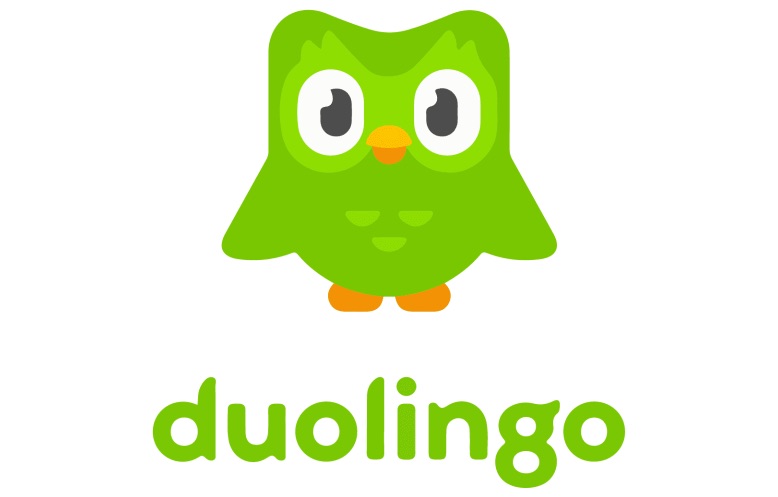
Duolingo is an app that’s hugely popular owing to the fact that you can learn languages for free, and it’s fun. It basically mimics the structure of a video game.
Lessons come in the form of new information and prompts to answer questions right from the get-go. You hear or read a word or phrase, then either type something, match something or say something into a voice recorder in response. Animated characters are used to make the lesson appealing and encourage you to answer.
While learning, you can level up, earn rewards (in-game currency used for character customization or bonus levels), get badges and set yourself challenges. There's also an optional competitive element: you can push yourself to advance beyond other learners.
What the makers say: “It's hard to stay motivated when learning online, so we made Duolingo so fun that people would prefer picking up new skills over playing a game.”
They’ve tried to include reading, writing, listening, and speaking skills – although there’s not much depth to these, to be honest. You can certainly learn a lot of vocabulary, but it’s all very visual and doesn’t take a huge amount of thinking in the new language.
What Is Babbel?

Babbel is an app that also has a huge following. It is similar to Duolingo in many ways, but also has some clear differences.
They offer interactive quiz-style lessons in which users are shown new material (vocab, phrases, grammar) and then asked questions throughout the lesson. The quiz exercises are similar to what you get in Duolingo, minus the animated cheerleaders! To advance through the quiz, you have to answer correctly.
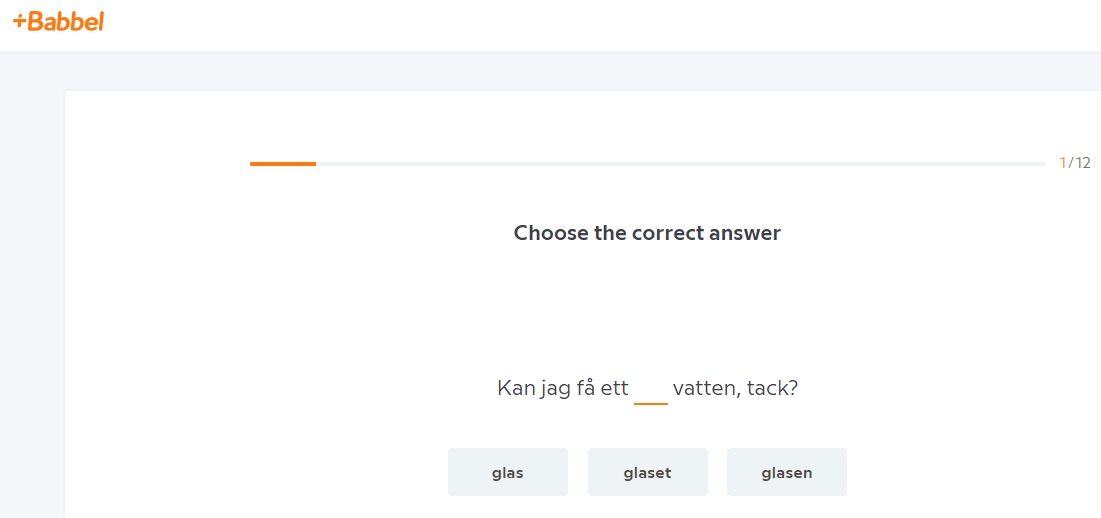
You can see your achievements and set yourself goals, but there’s no gaming element.
What the makers say: “Our aim is for learners to have a conversation right from the start, so the language lessons are built around realistic dialogues.”
Babbel teaches real-life dialogue from the first lesson, and their aim is to help you learn both actively and passively through context. For more information about Babbel, check out this Babbel review.
A Look At Duolingo’s Levels…
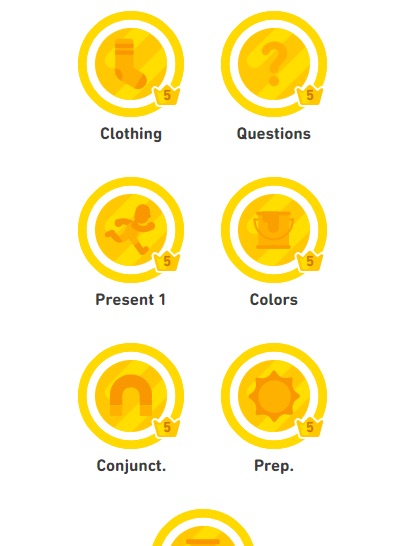
Duolingo doesn’t use traditional ‘beginner to advanced’ fluency levels. Instead, you complete language skill units that are arranged in a ‘tree’.
This tree represents your entire language course. You start at the top and work your way down, completing skills that get gradually harder. Each skill unit has 5 levels of difficulty and once you’ve completed all 5, you move to the next skill in that section. Each section offers both vocabulary and grammar lessons.
As you work your way down the tree, the types of exercises get more difficult. For example, you begin with lessons like ‘Basic Phrases’, ‘Plurals’ and ‘Food’, and progress to lessons like ‘Conditional Perfect Tense’, ‘Occupations’ and ‘Politics’.
There are also helpful grammar tips before each lesson.
If you're in the top 10 learners in your level each week, your name appears on a Leaderboard called ‘Leagues’. There are 10 leagues you can move up in as you progress on the course. If you’re competitive, this can push you to study more to reach first place.
I like that this method is fun and feel-good, so you’re unlikely to get bored as a beginner. The animated characters keep you engaged.
The lessons are pretty easy in the early stages and you’ll probably whizz through them, since the exercises have obvious clues when you’re stuck. Typical exercises are ‘Type what you hear’, ‘Mark the correct meaning’ and ‘Write this in (Italian)’. The recordings are clear and you can slow them down or press replay.
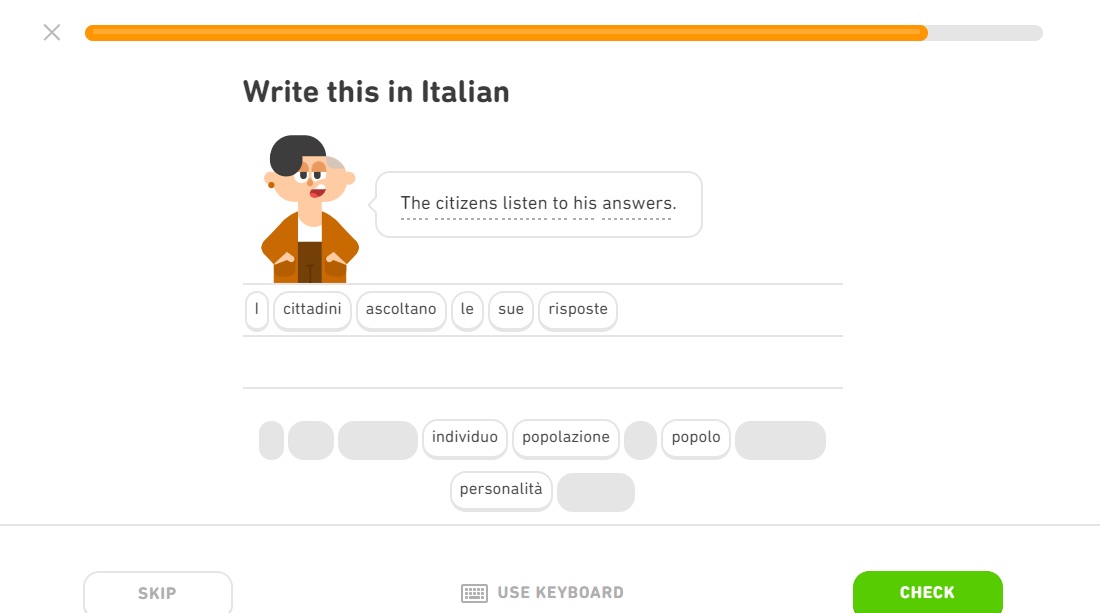
They get trickier as you progress, so you certainly will be challenged!
What I Like About Duolingo
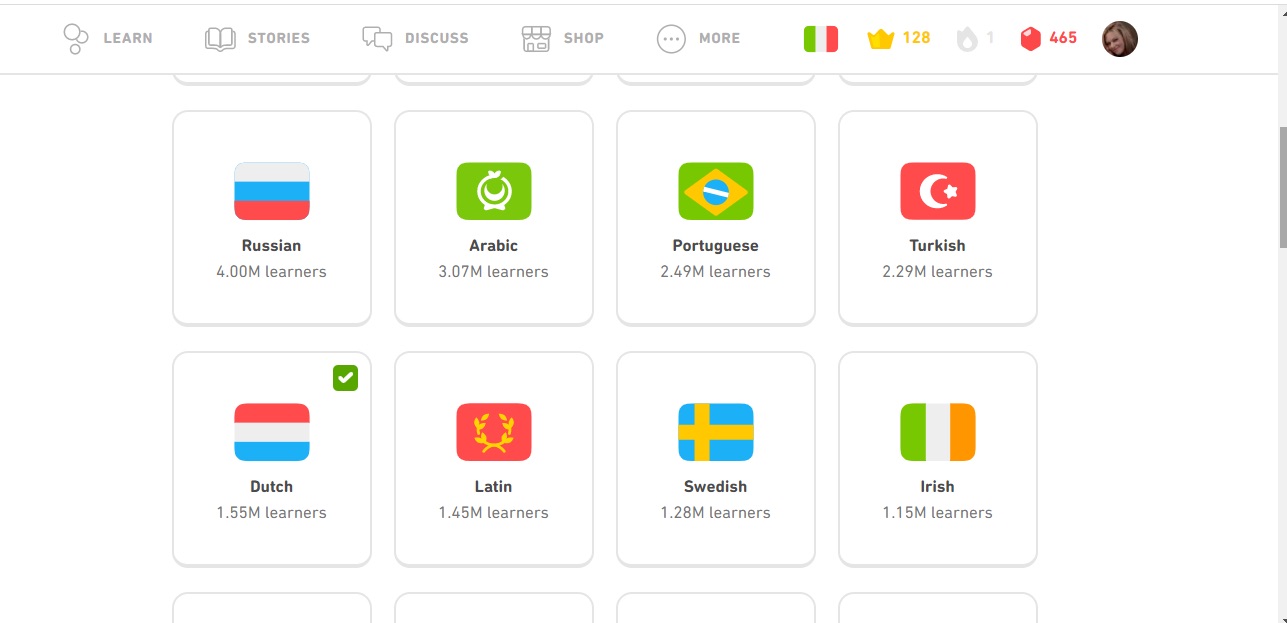
- The lessons are quick, fun and engaging, so you’re likely to do them even when you're a bit tired or not feeling motivated.
- It’s useful for learning vocabulary, phrases and basic sentence structure at beginner levels.
- It’s completely free to use and with so many languages to choose from, this opens up a whole world of language to explore. I love that Duolingo is so accessible to everyone, regardless of their situation.
- The app works very well across devices and your lessons are synched, which is convenient when you're on the go. You can easily do a quick lesson on your phone while standing in a queue, for example.
- The lesson reviews are optional, but you do get reminded and encouraged to do them regularly. This is helpful and pushes you to remember things you did weeks before.
- So many languages to choose from! This is awesome for beginners who aren’t sure what language to study and want to get exposure to a few different ones before committing.
- The Stories section is quite cool as it’s the only place you get to hear a more continuous flow of language. It’s designed to test your reading comprehension – an important skill. I like that you can click on and repeat the audio lines to hear them again. You can also hover the cursor over any word you don’t know, and the English will appear.
What I Don’t Like About Duolingo

- While popular courses like Italian teach useful phrases, other languages – especially the less mainstream ones – teach many silly, impractical sentences that you would never use.
- Certain languages have unnatural-sounding audio recordings, which does nothing for teaching you what the language actually sounds like. Swahili, for one, is pretty bad.
- There’s often only one acceptable translation per sentence prompt, so even if you write a correct answer, it can be marked as wrong – with no explanation! You can then discuss the answer in the community, but that doesn’t change anything.
- You can’t advance beyond early intermediate, so it’s ineffective in teaching students to speak a language properly.
- It’s in no way immersive – there’s a complete lack of cultural context, uninterrupted listening or opportunities to practice real-life conversations.
- There’s a bit too much freedom in choosing which ‘skill’ to do, resulting in poorly structured lessons that don’t always follow a logical order.
- The competitive ‘Leagues’ you can advance through are counterproductive; it’s easy to get so swept up in coming first, that you start placing quantity over quality in your lessons.
A Look At Babbel’s Levels…
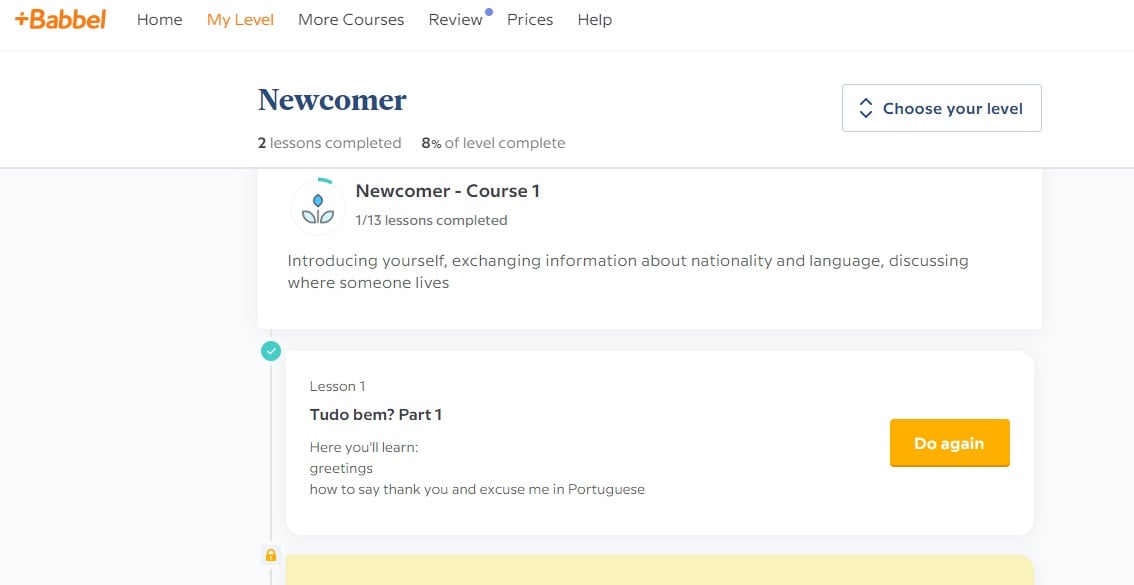
Babbel has 6 proficiency levels, from Newcomer to Advanced. Each level has 1 to 5 courses and inside each course is a number of lessons – roughly 7 to 12.
The courses follow particular themes, such as “Talking about your family”, “Numbers from 30 to 100” or “Outdoor activities”.
Your current course and the lessons you have to do are clearly displayed on your screen, and it shows you what percentage you’ve completed.
Leveling up with Babbel is completely different to Duolingo. It’s more traditional and you’ll work your way through a logical progression of fluency levels. That said, there’s nothing stopping you from skipping courses if you want to. You just can’t skip ahead while a lesson is in progress.
Babbel is not a game like Duolingo. The quiz-style questions are only for your own learning – there’s no competition with other players. Because of this structure, Babbel has the advantage over Duolingo when it comes to being taken seriously as a language course.
What I Like About Babbel
- Depending on the language, you can learn to a higher level than with Duolingo. Spanish and French are certainly winners here, with richer content.
- There are some really good opportunities for practicing your grammar, especially in the supplementary grammar section.
- Like Duolingo, Babbel is quite useful for learning vocabulary, phrases and basic sentence structure at the lower levels, which can give you a decent foundation in your language of choice.
- Babbel also introduces plenty of life-like sentences one can use naturally in conversations – particularly on the French and Spanish courses.
- The lessons have better structure than Duolingo, with a more ‘serious’ approach and more accountability.
- A few of the languages have podcasts, which is awesome! If only there were more of these, and for all their language courses. The most immersive experience you’ll get with Babbel is listening to some uninterrupted conversations in the podcasts.
What I Don’t Like About Babbel
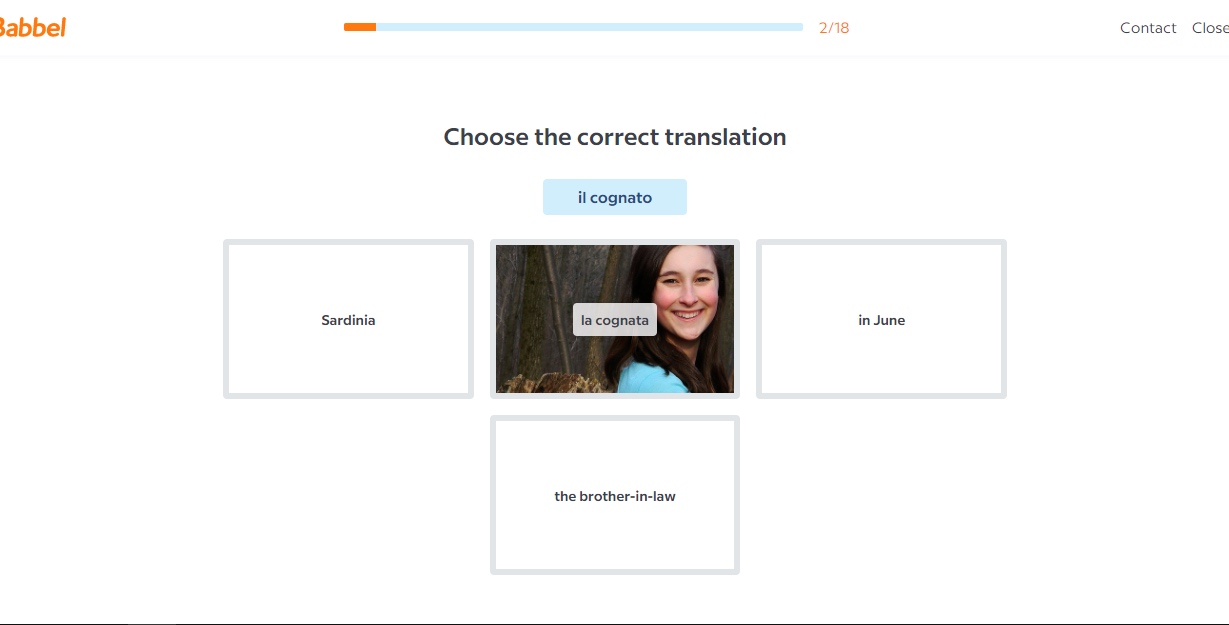
- The exercises are a bit tedious and not much fun to do. You can’t simply skip past any you don’t like, either, as a correct answer is required to move on.
- No opportunity to develop your speaking skills. Like Duolingo, Babbel is not exactly a deeply immersive encounter. One issue I have with the lessons is the fact that they seem entirely centered on vocab and grammar. This is definitely not ideal, since language absorption is about spending as much time as possible with the language.
- The lesson content is unevenly distributed. Lower levels have plenty of material to work with, but there’s too little content at higher levels.
- Only 13 languages to choose from, none of which are East Asian! So if you were hoping to learn Chinese, Japanese, Thai, Korean… Babbel won’t work for you.
- Far less content available for the less popular languages like Russian, Norwegian or Indonesian.
Babbel vs Duolingo: Review Options
Reinforced learning is vital! When you review what you’ve learned, it forces you to stop and observe how you’re really doing. You notice the gaps, and it strengthens your ability to remember in the long run.
Remember that if you were learning a language naturally (like a child) you’d be hearing the same phrases repeated all the time in everyday life, in different contexts. That’s how they stick!
So, how do Duolingo and Babbel measure up?
Duolingo uses a spaced-repetition system and this gets you to review what you’ve learned regularly, which is helpful. When the algorithm decides that you need to practice an old skill, the skill icon ‘cracks’ and you must review it to restore it. You don’t have to, but you’ll get irritated by the cracks if you don’t!
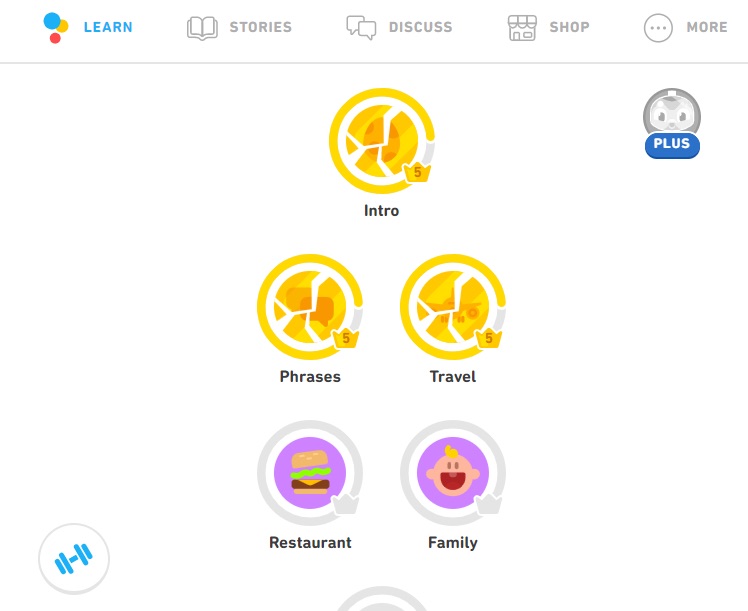
Babbel gives you four ways to review at the end of each lesson: with flashcards, or with listening, speaking or writing exercises. During the lessons, you’re obligated to review while you learn, since you can’t advance until you get an answer right. This helps keep you focused, since you can’t give lazy answers!
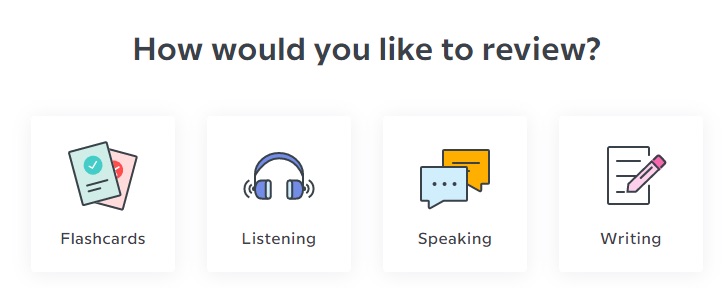
Babbel vs Duolingo: Extra Features
Duolingo has some extra features that are quite cool:
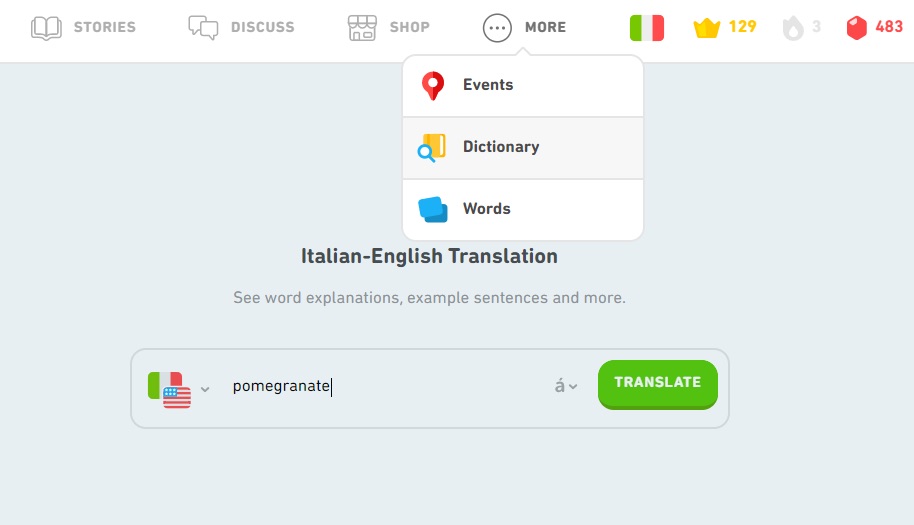
- A wordbank that shows all the words you’ve learned since you started. They work on a spaced-repetition system: Duolingo's algorithms figure out when you should practice words to get them into your long-term memory. At a glance, you can see your strong words down to your weak words, so you know what needs some practice.
- A searchable dictionary with all of the vocabulary from the lessons. Words you look up also come with a list of example sentences. Beneath this, you’ll see some related discussions from the forum.
- ‘Duolingo Stories’ are short, engaging interactive stories that give you extra reading and comprehension practice. They’re available on the Portuguese, Spanish, French and German courses.
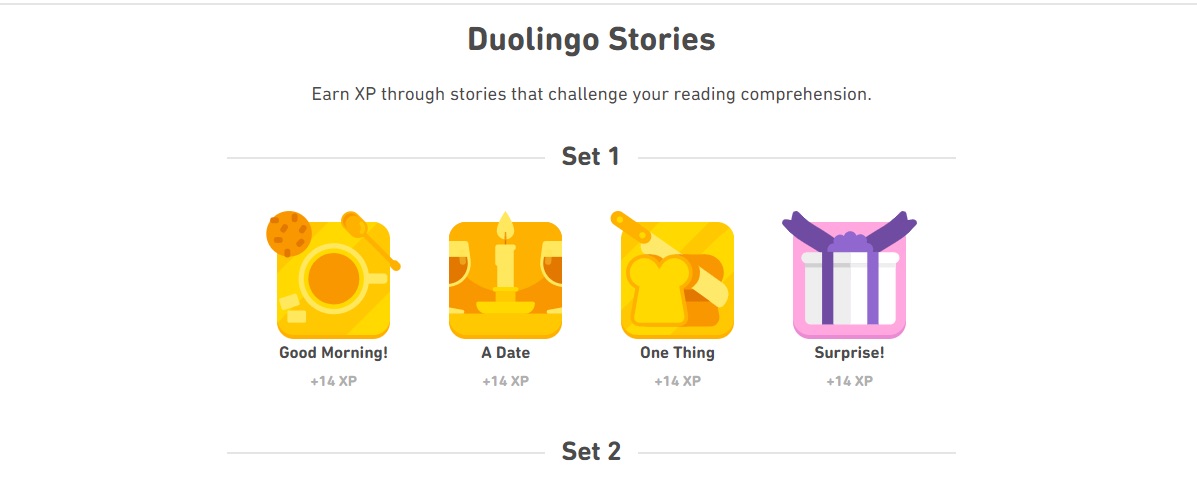
Babbel also has a few extra features you might find useful:
- A few supplementary courses per language, based on specific skills and interests – such as ‘Countries and Traditions’, ‘Idioms’ or ‘Love Letters’.
- Podcasts for learners studying Italian, German, French or Spanish. Some have quite a lot of English in them; others are monolingual. The Spanish-only podcast series called ‘Palabras Bravas’ is awesome!
- Babbel Live – optional live classes you can join for German, French and Spanish (at a fee).
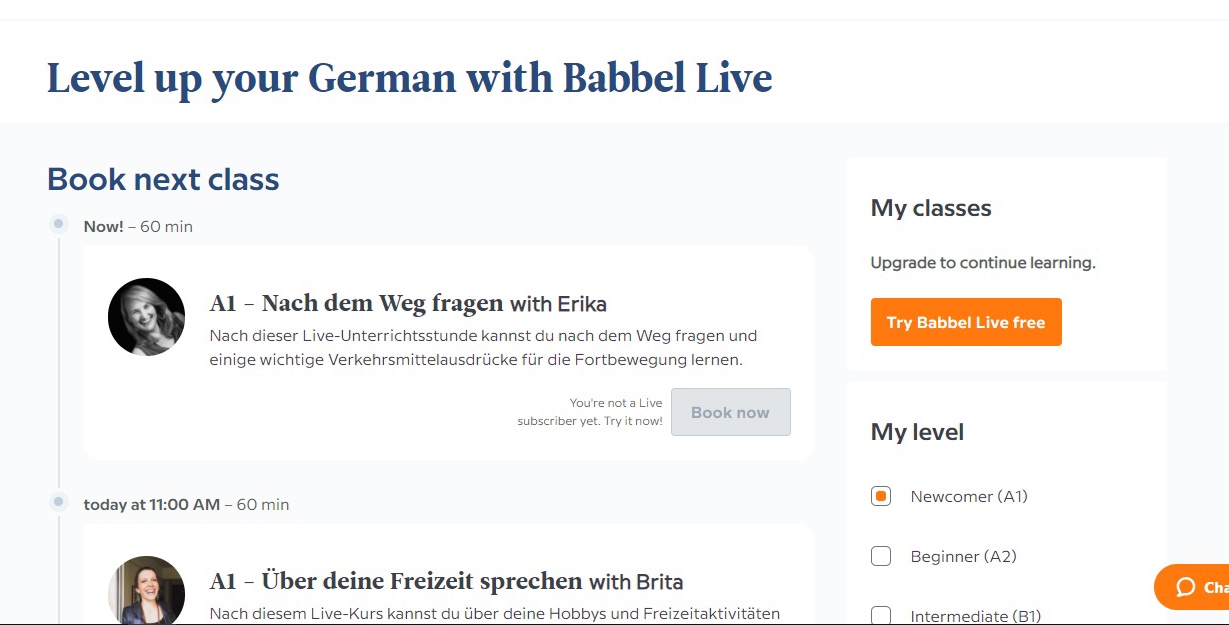
Babbel vs Duolingo: The Cost
Both Duolingo and Babbel make use of a freemium model, meaning it’s free to join and create a profile. You can then try them out in a trial period, after which you can upgrade to premium if you choose.
The big difference is Duolingo is free to continue learning, but Babbel is not.
Duolingo: After a 14-day trial period, you can continue learning for free and have access to most of the features. You may learn as many languages as you want to, at the same time, for as long as you want to. The upgrade to Duolingo Plus isn’t necessary for learning, but it has a few benefits: no ads, downloadable lessons, unlimited game perks and progress quizzes.
The cost of a 12-month Duolingo Plus subscription is $83.88 USD.

Babbel: After a 7-day trial period, during which you can try out the first lesson of each course, you will need to pay to keep learning. Prices are per language and as you may expect, the longer you subscribe for, the cheaper the deal. Babbel offers a 20-day money back guarantee.
The cost of a 12-month Babbel subscription is $ 83.40 USD.
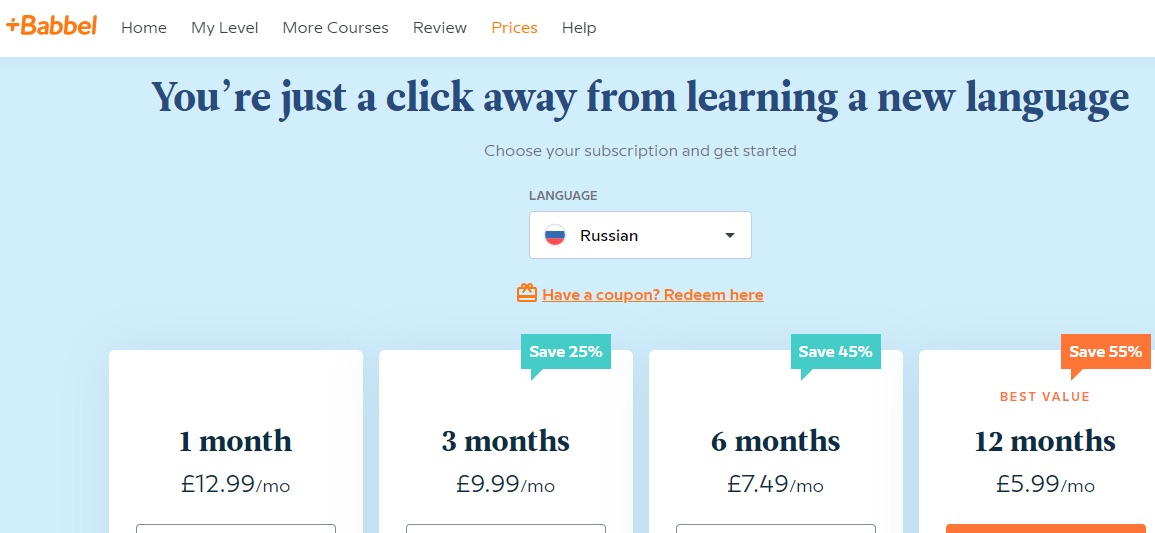
Final Verdict: Duolingo Or Babbel?
As a serious language learner, I have to say I’d skip the game-based courses altogether and head straight for a fully-immersive program. Why? Because I firmly believe in uninterrupted exposure to authentic language right from the start – and lots of it!
But… this doesn’t mean I don’t think these apps are useful. There’s something to be said for daily motivation and convenience while learning a language – especially on days when you literally have ten minutes to spare!
So, I think either Duolingo or Babbel have the potential to work for you as a supplement to a richer, more immersive course. If you want to give them a go, I think you’ll find them useful in these ways:
Duolingo: to keep you sharp in-between lessons. If your ‘real’ language lesson happens in the evenings, Duolingo can give you a boost during the day. You could play a round of Portuguese animal words in your coffee break, or practice introducing yourself in Korean on your morning run …
Babbel: to keep building your vocabulary base, practice your conversation skills and check up on grammar points that you get stuck on.
However, if you're looking for a comprehensive beginner programme that will take you all the way to an intermediate language level and that uses a much more fun, engaging and effective method, then I've got something that might suit you better…
StoryLearning: A Better Alternative To Duolingo Or Babbel

While these apps can be fun and motivating for beginners, neither of them have what it takes to give you a truly exciting, immersive experience while you learn a language.
That's where Uncovered is different.
Uncovered is a comprehensive online beginner course that takes you from a complete beginner in a language, up to an intermediate level. And it's fuelled by a fun and unique method called StoryLearning®.
StoryLearning is a process that was invented to teach you languages naturally. It’s so natural, in fact, that it’s based on how human beings learn their native language.
In the course, you'll learn through an exciting original story in your language of choice, written especially for beginner learners. Every word is intentional, designed for optimal learning to take place.
Though you learn through story, you also have a teacher and experienced language learner by your side all the way through the course. She offers support with explanations in English and tips to help you learn the material fast.
Uncovered teaches all of the key aspects of the language: reading, listening, vocabulary, grammar, pronunciation and speaking. So by the time you've finished, you'll be a confident intermediate level language speaker, ready to go out and actually use your new language in the real world!
What You Get With Uncovered
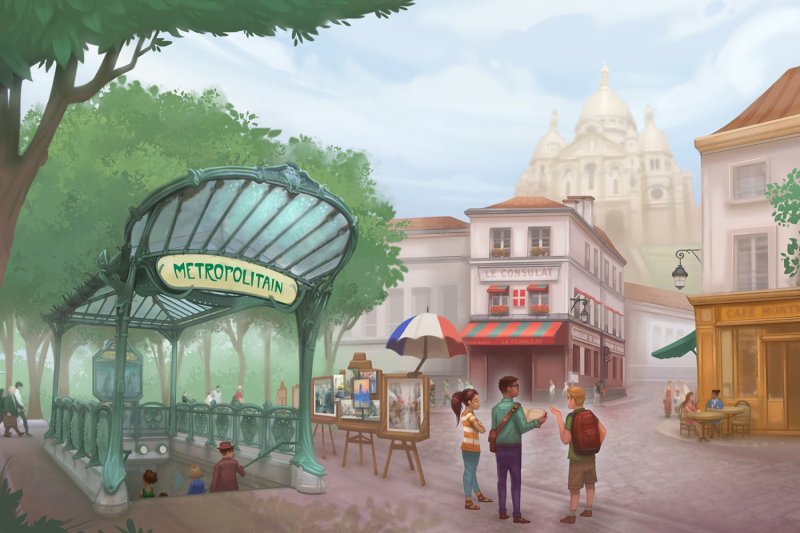
- Complete 20-module course to learn to speak your new language with confidence through StoryLearning™. This is a method that relies on your brain's natural way of learning.
- 80+ video lessons with your experienced language teacher. You'll learn with the same method that's attracted worldwide attention, from the BBC, Independent, Open University, European Commission, El País, and more!
- Learn the secrets I used to learn 8 languages and how to use them yourself to learn to speak with confidence & take part fully in conversations with native speakers.
- Fully downloadable programme so you can learn faster – anywhere, any time, and on any device… even without an internet connection!
- Complete learning material, including audiobook, translations, printable worksheets… everything you need to get started and find success with your language learning!
- Expert pronunciation training videos, so you can perfect your pronunciation and speak like a native from the start.
- Money-back guarantee, so you can buy without risk today, and get a full refund if you don't love it.
If you're determined to learn a language and looking for the most fun and effective language course around, I'm confident you'll love Uncovered!
Ready to start? Click here to find out more about Uncovered and start your language learning journey.

Olly Richards
Creator of the StoryLearning® Method
Olly Richards is a renowned polyglot and language learning expert with over 15 years of experience teaching millions through his innovative StoryLearning® method. He is the creator of StoryLearning, one of the world's largest language learning blogs with 500,000+ monthly readers.
Olly has authored 30+ language learning books and courses, including the bestselling "Short Stories" series published by Teach Yourself.
When not developing new teaching methods, Richards practices what he preaches—he speaks 8 languages fluently and continues learning new ones through his own methodology.








































